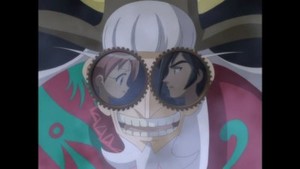Princess Tutu
Episodes 9-10
by Rebecca Silverman,
How would you rate episode 9 of
Princess Tutu ?
Community score: 4.6
How would you rate episode 10 of
Princess Tutu ?
Community score: 4.4

Once upon a time, there was a little girl, pretty and dainty. Those words could come from almost anywhere, but for our purposes, they're the opening line of Hans Christian Andersen's literary fairy tale The Red Shoes, dating to 1845. The story tells the tale of Karen, a poor girl who is one day given a pair of red shoes that she becomes obsessed with and overly proud of, and one day she is cursed by an angel, who tells her, “dance in your red shoes till you are pale and cold, till your skin shrivels up and you are a skeleton! Dance you shall, from door to door, and where proud and wicked children live you shall knock, so that they may hear you and fear you! Dance you shall, dance—!” In the end, the girl has her feet cut off, and they dance away without her, never to be seen again. It's a cruel story, as so many of Andersen's are, and in the case of Princess Tutu, it applies specifically to Rue in her Princess Kraehe (German for crow, more commonly spelled “krähe”) form. Kraehe's shoes, whose ribbons creep up her legs like thorny vines before digging into her flesh, aren't the bright red of Andersen's shoes, but the dark, rusty black of old blood. And when she has them on, Kraehe has no choice but to dance as the story dictates.
Despite this, Rue, whose name means “disdain” in the language of flowers, isn't as villainous as she and Drosselmeyer want us to believe. In fact, she bears a marked resemblance to the wicked fairy in Sleeping Beauty, whose crime was driven by jealousy and a fear of being left out because she wasn't needed. This is borne out by the thorny vines I mentioned before; in the German and French variants of ATU 410, when the princess falls asleep, the castle is protected by a vicious tangle of thorns, which here are used to transform Rue into Kraehe, implying that her transformation is driven by her uglier feelings, but also that underneath them is a princess slumbering – perhaps Rue's true self, untainted by jealousy or Drosselmeyer's machinations. When it is remarked this week that a prince doesn't need two princesses, it's not only a reference to the tale I mentioned before, The White Bride and the Black One, but a direct statement about what Rue truly fears – that she's an extraneous character who has no role to play in the story of the prince she loves.
In terms of the tales mentioned directly this week, we can also read Kraehe as one of the stepsisters in Cinderella, the one deemed not good enough and not pretty enough to win the prince. In human form, that's more of a role that Duck plays, but when they're transformed, we could argue that Kraehe is the stepsister to Tutu's shining princess, something further symbolized in their magical girl outfits: Tutu's is the classic prima ballerina look, with a fluffy tutu and an innocent color scheme, while Kraehe's is the dark shade of symbolic evil and exposes much more skin, painting her with the Victorian taint of sexual knowledge. (Which, interestingly enough, is part of the story known as Donkeyskin, classified as “Cinderella B.”) Kraehe isn't just fighting for the man she loves, she's struggling to mark out her own place in the story, to prove that she's more than just the extraneous princess – in a very real sense, laboring under the burden of Story.
That's true of Fakir as well, whose abusive boyfriend attitude towards Mytho is finally explained in these episodes. Mytho fell out of the story and into Fakir's life like Athena springing fully grown from Zeus – Fakir was an orphaned child and Mytho was much the same as he is now. When Fakir and his guardian realized that Mytho had no heart yet was alive, they saw that he was mythos, or myth, sprung to life in the real world, the Nameless Prince of folklore suddenly in their home. Fakir, still mourning the deaths of his parents, saw Mytho's princely nature wherein he protected the weak as a possible reason why his friend would leave him the same way his parents did, and he took advantage of Mytho's blank-slate personality to keep him by his side, bringing us to where we are now – with Fakir's old fears still lingering in his heart as he desperately tries to keep someone he loves beside him. Once again, it is the perversion of the white knight ideal, but together Mytho and Fakir also appear to represent the Swan Knight, a figure from Medieval folklore whose heroics endure as long as his name is unknown. The story is probably best known from Wagner's 1848 opera Lohengrin, but it has Arthurian and Crusades-era variants as well. The most salient point right now is that the Knight appears in a boat led by a swan – which feels like foreshadowing now that Fakir and Duck are getting closer.
The story is beginning to unravel. Drosselmeyer appears to Rue for the first time, and Edel (whose name is an old German word for “noble”) appears to Fakir to make him ponder the nature of Story and his role in it. She may be a puppet, but the meaning of her name and the way the story is straining at it bonds mean that we can't make any assumptions about that – like the original Herr Drosselmeyer's creations, Edel may be more than a simple toy.
Rating:
Princess Tutu is currently streaming on HiDive.
discuss this in the forum (55 posts) |
back to Princess Tutu
Episode Review homepage / archives